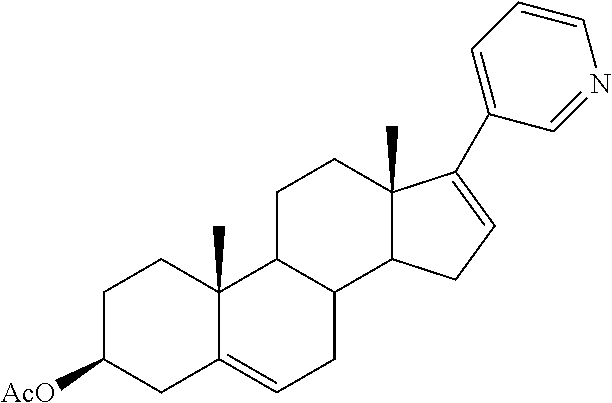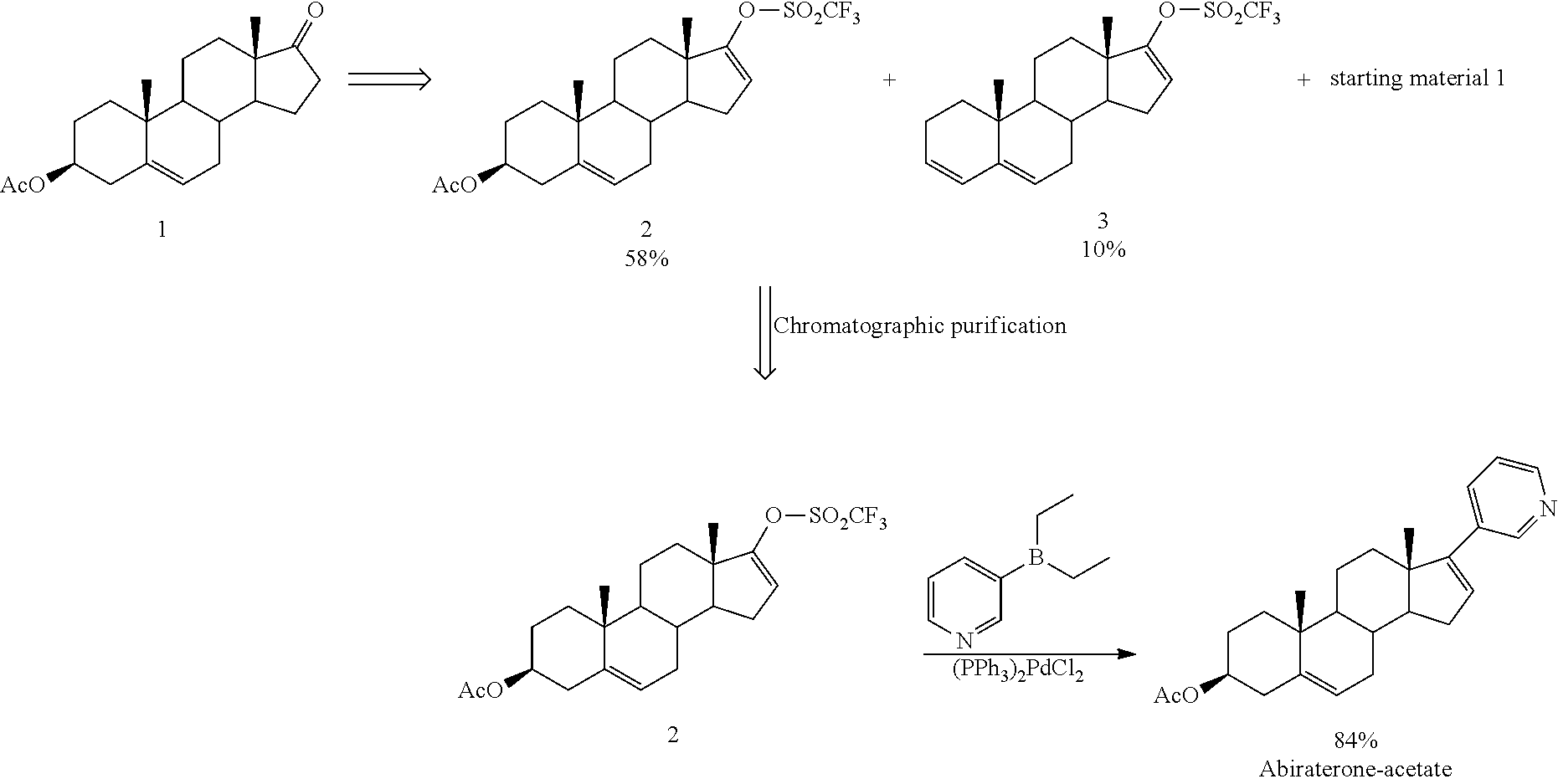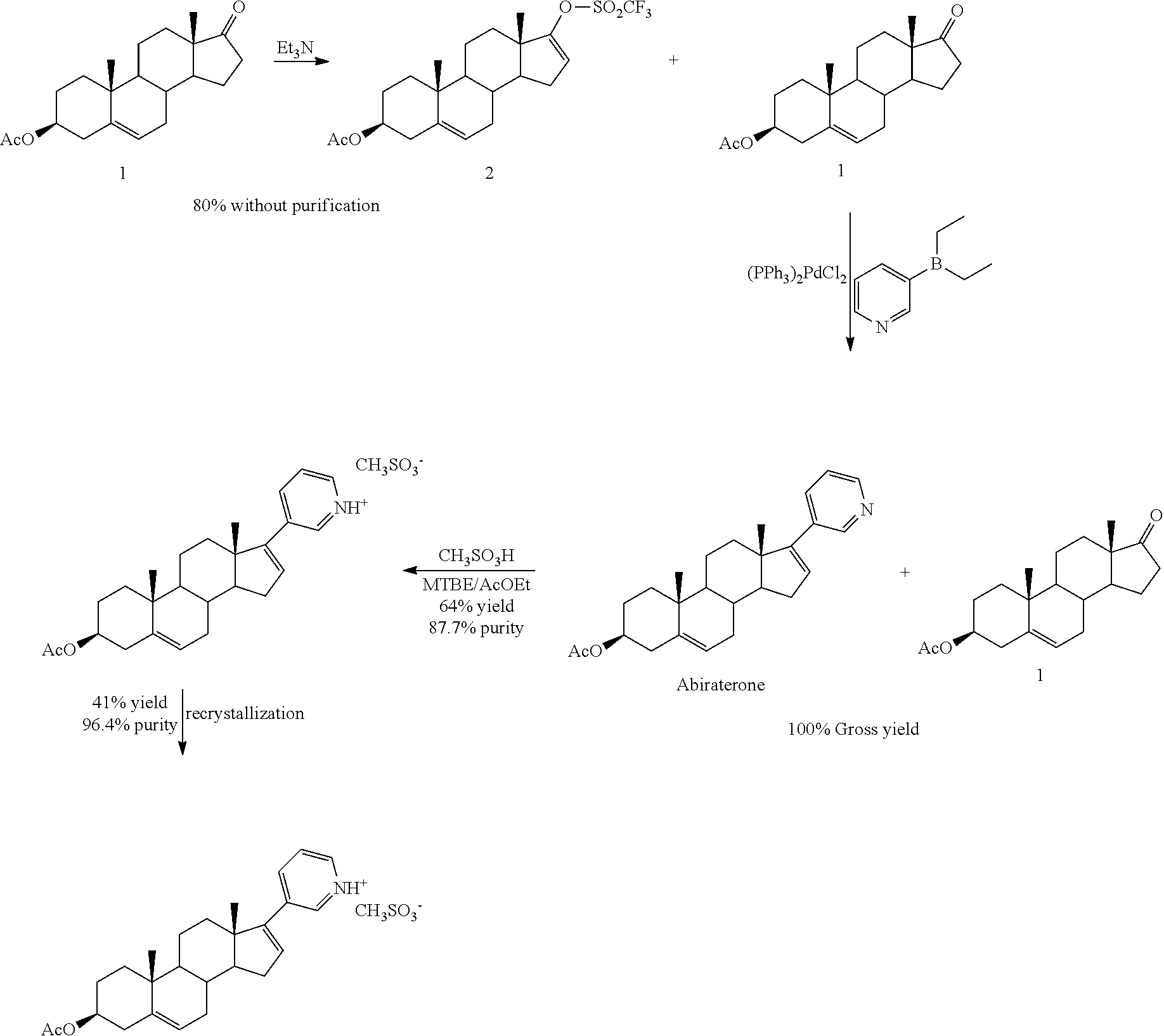Synthesis of abiraterone and related compounds
a technology of abiraterone and related compounds, which is applied in the direction of steroids, organic chemistry, etc., can solve the problems of long reaction time and inability to carry out the process in practi
- Summary
- Abstract
- Description
- Claims
- Application Information
AI Technical Summary
Benefits of technology
Problems solved by technology
Method used
Image
Examples
example 1
Synthesis of 5-Dehydroepiandrosterone-17-Hydrazone
[0181]
[0182]Hydrazine monohydrate (9.75 ml, 200 mmol) and a solution of hydrazine sulfate (0.0325 g, 0.25 mmol) in water (1 mL) was added to a suspension of 5-DHEA 1 (14.4 g, 49.93 mmol) in ethanol (250 mL). The mixture was stirred at room temperature for about three days and was followed by TLC. The reaction mixture was poured into water (1 L) and the resulting white precipitate was filtered and washed with water (3×30 ml) and ether (3×10 ml). The title compound was obtained as a crystalline solid (95% yield).
example 2
Synthesis of 17-iodo-5,16-androstadien-3-ol
[0183]
[0184]A solution of compound 2 (14 g, 46.28 mmol) in THF (350 mL) was slowly added (for about 1 hour) through an addition funnel to an ice-cold solution of I2 (24.67 g, 97.19 mmol) and 1,1,3,3-tetramethylguanidine (29 ml, 231.4 mmol) in THF (920 mL). When the reaction was complete, the mixture was filtered and the filtrate was concentrated under vacuum to yield a brown oil. The oil was dissolved in ether, washed with HCl 1M until the aqueous phase was acidic and then sequentially washed with NaOH 0.5 M, Na2S2O3 1M and water. The organic phase was separated, dried over MgSO4 and concentrated under vacuum to yield a product which was crystallized from ether / heptane (90% yield).
example 3
Synthesis of 3-((tert-butyldimethylsilyl)oxy)-17-iodo-5,16-androstadiene
[0185]
[0186]Imidazol (2.87 g, 42.14 mmol) was added to a suspension of compound 3 (3.5 g, 8.78 mmol) in methylene chloride (30 ml). The mixture was stirred for 10 minutes until complete dissolution of the reagents. TBDMSCl was then added (1.85 g, 12.30 mmol). The reaction mixture was stirred at room temperature for 1 h and followed by TLC. The solvent was evaporated under vacuum yielding a white precipitate which was washed with HCl 1M (2×20 ml) and then with water (90% yield).
[0187]1H-NMR (400 MHz, CDCl3): 6.14 (dd, J=3.2, 1.7 Hz, 1H), 5.32 (d, J=5.3 Hz, 1H), 3.48 (s, 1H), 1.03 (s, 3H), 0.89 (s, 9H), 0.75 (s, 3H), 0.06 (s, 6H).
[0188]13C-NMR (400 MHz, CDCl3): 141.9, 137.5, 120.6, 112.7, 72.5, 54.8, 50.5, 49.9, 42.7, 37.2, 36.8, 36.1, 33.7, 32.0, 31.2, 31.0, 25.9, 20.8, 19.3, 18.3, 15.1, −4.6.
PUM
 Login to View More
Login to View More Abstract
Description
Claims
Application Information
 Login to View More
Login to View More - R&D
- Intellectual Property
- Life Sciences
- Materials
- Tech Scout
- Unparalleled Data Quality
- Higher Quality Content
- 60% Fewer Hallucinations
Browse by: Latest US Patents, China's latest patents, Technical Efficacy Thesaurus, Application Domain, Technology Topic, Popular Technical Reports.
© 2025 PatSnap. All rights reserved.Legal|Privacy policy|Modern Slavery Act Transparency Statement|Sitemap|About US| Contact US: help@patsnap.com



